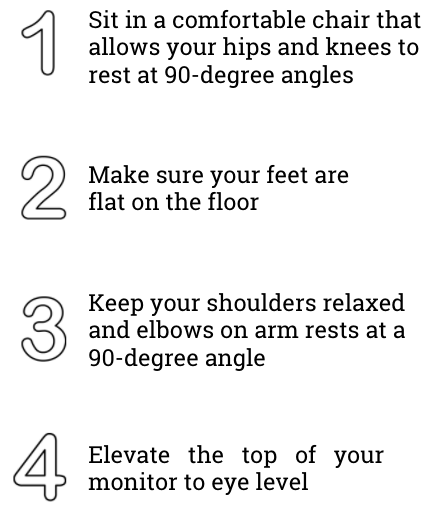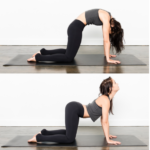Working from home is here to stay
The spring of 2020 saw more people than ever working from home and as this temporary solution became a long-term reality, our daily routines changed but our work from home (WFH) set-ups did not. Unprepared for the longevity of this arrangement, people have been displaced to kitchen counters, spare bedrooms, or the living room sofa for far longer than anticipated and have the neck and back pain to show for it. Not only is the lack of proper desk ergonomics contributing to these new-found body aches; we are no longer walking to meetings down the hall, popping into the break room for coffee, or getting up to go to the printer – people aren’t moving and it’s wreaking havoc on your body. Let us show you how to survive working from home WITHOUT neck and back pain.
You don’t need expensive equipment to be comfortable working from home
 Would it be best if everyone had access to a custom office chair, sit-to-stand desk, and adjustable monitors? Yes. Is this realistic? Of course not – this is where the 90/90 Rule comes in. Research has shown that our bodies expend the LEAST amount of energy keeping us upright when we assume certain positions. This means that the muscle fatigue, joint stiffness, and overall body aches we associate with sitting at a desk can all be reduced if we modify our work stations! An ergonomic setup will look a little different for everyone depending on the specialized equipment you have available to you but here are the general guidelines
Would it be best if everyone had access to a custom office chair, sit-to-stand desk, and adjustable monitors? Yes. Is this realistic? Of course not – this is where the 90/90 Rule comes in. Research has shown that our bodies expend the LEAST amount of energy keeping us upright when we assume certain positions. This means that the muscle fatigue, joint stiffness, and overall body aches we associate with sitting at a desk can all be reduced if we modify our work stations! An ergonomic setup will look a little different for everyone depending on the specialized equipment you have available to you but here are the general guidelines


Investing in an adjustable office chair is the ideal place to start but if that isn’t an option for you there are easy modifications that can be made with things found around the house! Feet don’t touch the floor? No problem! Place a small stool, box, or stack of books in front of your chair so your feet are supported. Sitting in a dining room chair? Roll up a towel or place a small pillow behind the curve of your low back to encourage proper posture and increase support while sitting.
Monitor isn’t adjustable? Position it on a box or stack of books until it sits at the right height for you. Many people find themselves working on laptop computers which are challenging to modify on their own. We recommend using a separate external mouse and keyboard and elevating the laptop in front of you the same way you would with a desktop monitor.
Reduce neck and back pain with these FIVE simple changes

If you spend much of your day on the phone, try using a headset or earphones instead of holding your phone. This will improve your posture by allowing you to maintain the 90/90 Rule at your desk. Working with an external mouse to avoid using a laptop trackpad is another easy way to reduce the tension in your body over the course of the day. When we repetitively reach across our desks for printers, staplers, pens, and paperclips it can lead to unnecessary pain and stiffness. We suggest organizing frequently-used items to be within reach.
Easy exercises to get you started
 Neck Stretch
Neck Stretch
Sitting up tall anchor your arms by holding onto your chair or sitting on your hands. Tilt the head to one side bringing your ear to your shoulder. You should feel a stretch on the opposite side of the neck. Hold this position for 2-3 sets of 20-30 seconds.
Mid-Back Movement
For Open Book begin lying on your side with your head supported on a pillow or towel, your legs slightly bent, and your arms stretched out in front of you. Bring your top arm across your body and back back behind you, turning your head to look at your hand. Hold here for 10-20 seconds and return to the starting position.
 Low-Back Movement
Low-Back Movement
Start on your hands and knees on the floor for Cat/Cow. Round your back upwards, tuck the hips under, and bend the neck forward to look at your belly button. Then move in the opposite way by arching the back, bringing the belly towards the floor, sitting the hips out, and trying to look up to the ceiling. Slowly alternate between these positions to loosen up the back.
Chest Stretch
To stretch the Pec Muscles stand in a small lunge in a doorway with one hand and forearm resting along the door frame. Keep the elbow lower than the shoulder and lean forward to feel a stretch across the front of the shoulder. Hold this position for 2-3 sets of 20-30 seconds.
 Core and Back Strengthening
Core and Back Strengthening
Include abdominal stabilization and mid-back strengthening exercises into your workout routine focusing on form. It is best to reduce the weight you’re using and aim for an endurance repetition range of 2-3 sets of 12-15 reps of each exercise.

